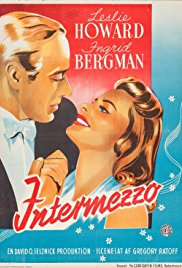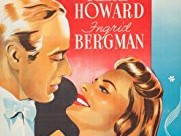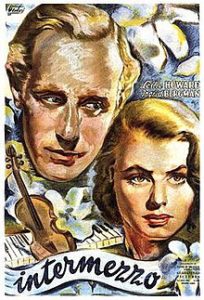Intermezzo: A Love Story **** (1939, Ingrid Bergman, Leslie Howard, Edna Best) – Classic Movie Review 6679
It is time to get your box of handkerchiefs at the ready for director Gregory Ratoff’s irresistibly charming 1939 romantic drama tearjerker that launched the American career of Ingrid Bergman, who had already appeared in Intermezzo, the 1936 original Swedish version of this archetypal story about a young piano teacher called Anita Hoffman (Bergman) in love with a married, older virtuoso concert violinist named Holger Brandt (Leslie Howard).
They meet because Anita is the piano teacher of Holger’s daughter Ann Marie (Ann E Todd). After Holger invites Anita to accompany him on his next concert tour, a passionate relationship ensues and Holger’s wife Margit (Edna Best) seeks a divorce.
Intermezzo is Bergman’s show but, even so, Bergman still gets second billing to the male star, as she did in 1936. But then, perhaps surprisingly, Howard was one of the biggest box-office draws and movie idols of the Thirties.
Intermezzo was a big hit and there were two Oscar nominations – for Gregg Toland for Best Cinematography Black-and-White and for Louis Forbes for Best Music, Scoring. Though it is filmed in Black-and-White, the poster is in misleading garish colours. Wasn’t that a clue to the producer that the movie should have been in colour too?
Instead, producer David O Selznick was worried about Bergman’s height (‘Do you think we will have to use stepladders with Leslie Howard?’). But he need not have worried. Her warmth, beauty and sincerity effortlessly conquer all apparent obstacles. Incidentally, Bergman was tall but not that tall. She was 5′ 9″ and Howard 5′ 10″, so no actual stepladders were needed.
Intermezzo runs 70 minutes, is made by Selznick international Pictures, is released by United Artists, and is scored by Robert Russell Bennett, Max Steiner, Heinz Provost, and Christian Sinding. The musical director is Louis Forbes and the art direction is by Lyle R Wheeler.
The 1936 theme music Intermezzo with lyrics by Robert Hemming and music by Heinz Provost was a big hit and it was released in 1940. The film features multiple orchestrations of Intermezzo, which won a contest associated with the 1936 film.
George O’Neil’s screenplay is based on the original 1936 story by Gustaf Molander and screenplay by Gustaf Molander and Gösta Stevens.
Gregg Toland replaced original cinematographer Harry Stradling Sr, shooting in black and white. Irene designed Bergman’s costumes.
Also in the cast are John Halliday, Edna Best, Cecil Kellaway, Ann E Todd, Enid Bennett, Douglas Scott, Maria [Marie] Flynn, Eleanor Wesselhoeft, Holmes Herbert, Doris Lloyd and Edmund Mortimer.
It is also known as just plain Intermezzo and was re-titled Escape to Happiness in the UK.
Intermezzo was remade again as Honeysuckle Rose (1980) with Willie Nelson.
Professional musicians dubbed the musical duets but Howard and Bergman’s hands show the actual music being played. Bergman was a pianist and plays the full piano parts for Edvard Grieg’s Concerto in A minor and Christian Sinding’s Rustle of Spring, and her hand positions are correct for the music soundtrack.
Howard could not play the violin, so Al Sack, a lookalike violinist, taught him violin posture and bowing technique. Sack rested out of shot on Howard’s knees during filming and did the fingering on the close-ups and he doubles for Howard in the orchestra long shots.
© Derek Winnert 2018 Classic Movie Review 6679
Check out more reviews on http://derekwinnert.com




